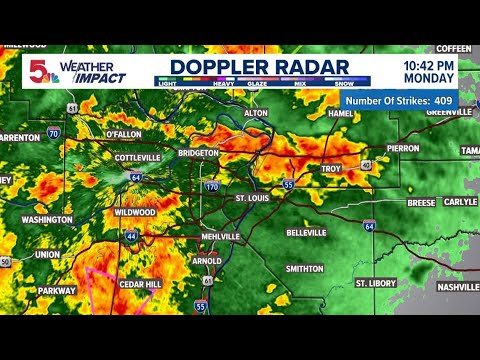Decoding kmov Weather: An In-Depth Exploration of Forecasts, Alerts, and Community Impact
This comprehensive article delves into the intricate world of kmov weather, exploring the relationship between weather forecasts, alerts, and their impact on the St. Louis community. By synthesizing information from various sources, including discussions about tornado warnings, severe storm alerts, and residents’ experiences during weather events, we aim to provide a deeper understanding of how kmov weather affects the region and what measures are in place to ensure public safety.
Understanding Weather Alerts: Tornado Warnings and Severe Storms
The relationship between weather alerts and severe weather events like tornadoes and storms is crucial for public safety. Content such as “Live radar: Tornado warning issued for several counties in Missouri, Illinois” highlights the synergistic connection between these alerts and the actual weather phenomena. Advances in alert systems can catalyze innovation in how we understand and prepare for storms, creating a positive feedback loop that improves forecasting and response times.
[IMAGE: https://i.ytimg.com/vi/fC_zTRucWJE/hqdefault_live.jpg Alt Text: Live radar showing a tornado warning issued for several counties in Missouri and Illinois.]
The real-world application of these alerts is significant, particularly in sectors like weather-related fields and innovative industries. Effective alerts play a vital role in addressing complex global issues and weather-specific problems, showcasing how theoretical concepts translate into practical solutions.
The Importance of Real-Time Weather Radar
The availability of live radar, as mentioned in “Live radar: Tornado warning issued for several counties in Missouri, Illinois,” is a cornerstone of modern weather forecasting. Radar technology allows meteorologists to track storm movements, assess their intensity, and issue timely warnings to affected areas. This real-time information is critical for residents to take necessary precautions and ensure their safety during severe weather events.
Debunking Misconceptions About Weather Forecasting
Many people mistakenly believe that understanding weather patterns is straightforward. However, analyzing events like those described in “Live radar: Tornado warning issued for several counties in Missouri, Illinois” reveals a more intricate and detailed reality. The depth and complexity of weather forecasting are often underestimated by casual observers, making it essential to appreciate the nuances involved.
The Impact of Storms on the St. Louis Area
Content such as “Weather Impact Alert: Severe storms later tonight in St. Louis area” underscores the importance of understanding the potential effects of storms on the St. Louis community. These alerts are designed to inform residents about the anticipated severity of upcoming weather events and provide guidance on how to prepare and stay safe.
[IMAGE: https://i.ytimg.com/vi/0UMsngGXICo/hqdefault.jpg Alt Text: Weather Impact Alert showing severe storms expected later in the St. Louis area.]
Methodologies for Understanding and Implementing Storm Preparedness
A structured approach to understanding and implementing storm preparedness involves several key stages:
- Comprehensive Preliminary Research and Data Gathering: Collecting relevant data about historical weather patterns and potential risks.
- Rigorous Analysis: Analyzing the collected data to identify trends and vulnerabilities.
- Strategic Planning and Hypothesis Formulation: Developing strategies and plans to mitigate risks and protect the community.
- Iterative Implementation: Implementing the plans and strategies in a phased approach.
- Continuous Monitoring and Adaptive Feedback Loops: Monitoring the effectiveness of the implemented plans and making necessary adjustments based on feedback and new information.
Case Study: Enhancing Alert Capabilities
Imagine a project where storm preparedness strategies are meticulously applied to enhance alert capabilities in the St. Louis area. The outcomes, hurdles encountered, lessons learned, and best practices derived from such an application, as detailed in sources like “Weather Impact Alert: Severe storms later tonight in St. Louis area”, can be incredibly instructive and offer valuable takeaways for similar endeavors.
Community Experiences and the Role of Sirens
“St. Louis City residents say sirens did not go off during Friday’s storm” highlights a critical aspect of weather preparedness: the effectiveness of alert systems in reaching the community. This content emphasizes the importance of ensuring that residents receive timely and accurate warnings during severe weather events.
[IMAGE: https://i.ytimg.com/vi/Bw3jCud4KFs/hqdefault.jpg Alt Text: St. Louis City residents discussing whether sirens went off during Friday’s storm.]
Addressing Misconceptions About Emergency Sirens
It’s important to address misconceptions about emergency sirens and their role in alerting the public. While sirens are a valuable tool, they are not the only means of communication. Residents should also rely on other sources of information, such as weather radios, television broadcasts, and online alerts, to stay informed about potential threats.
The Importance of Community Feedback
Exploring the impact of residents’ experiences on weather preparedness can add another layer of understanding. Discussions on ethical considerations and socio-economic shifts driven by the adoption of new technologies, as subtly present in content like “St. Louis City residents say sirens did not go off during Friday’s storm”, show how interconnected these ideas truly are and what broader effects they might have.
Frequently Asked Questions (FAQ)
Q: Why is it important to understand the relationship between weather alerts and severe weather events?
A: Understanding this relationship is crucial for public safety. It allows residents to prepare for potential threats and take necessary precautions to protect themselves and their property.
Q: What are some common misconceptions about weather forecasting?
A: Many people mistakenly believe that weather forecasting is straightforward. However, it is a complex field that requires expertise and sophisticated technology to accurately predict weather patterns.
Q: How can residents stay informed about weather alerts and warnings?
A: Residents can stay informed by monitoring weather radios, television broadcasts, online alerts, and social media channels.
Q: What steps can be taken to improve storm preparedness in the St. Louis area?
A: Improving storm preparedness involves comprehensive research, rigorous analysis, strategic planning, iterative implementation, and continuous monitoring and adaptive feedback loops.
Conclusion: Synthesizing Knowledge for a Safer Community
In conclusion, understanding kmov weather requires a comprehensive approach that encompasses weather alerts, community impact, and technological advancements. By synthesizing information from various sources, including discussions about tornado warnings, severe storm alerts, and residents’ experiences, we can gain a deeper appreciation of the challenges and opportunities in ensuring public safety during severe weather events. Continuous learning, critical thinking, and interdisciplinary collaboration are essential for navigating the dynamic field of weather forecasting and preparedness, ultimately leading to a more resilient and safer community in the St. Louis area. The importance of understanding the intricate relationship between issued alerts and the impact those alerts have on a community cannot be overstated, especially when the safety and well-being of residents depend on it.






